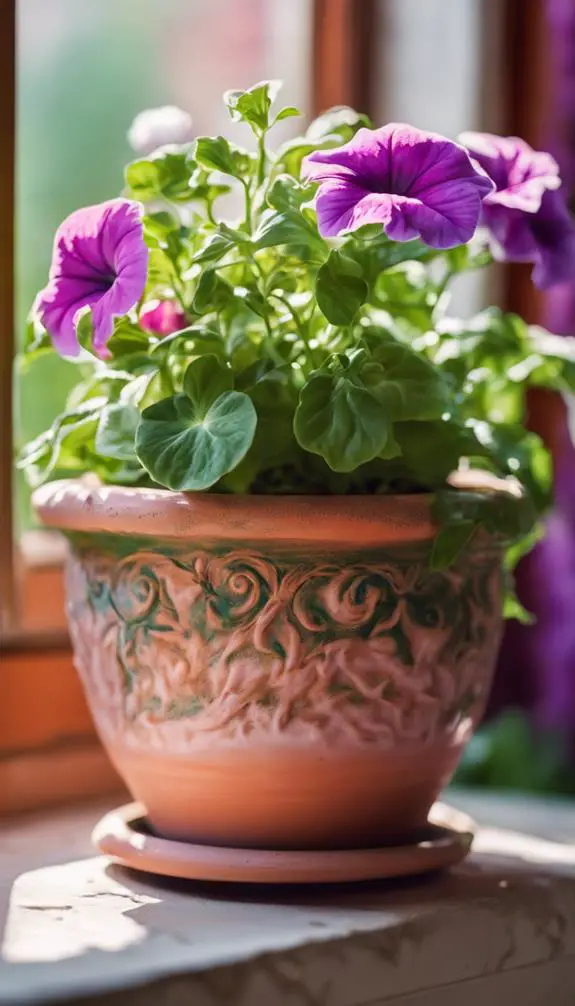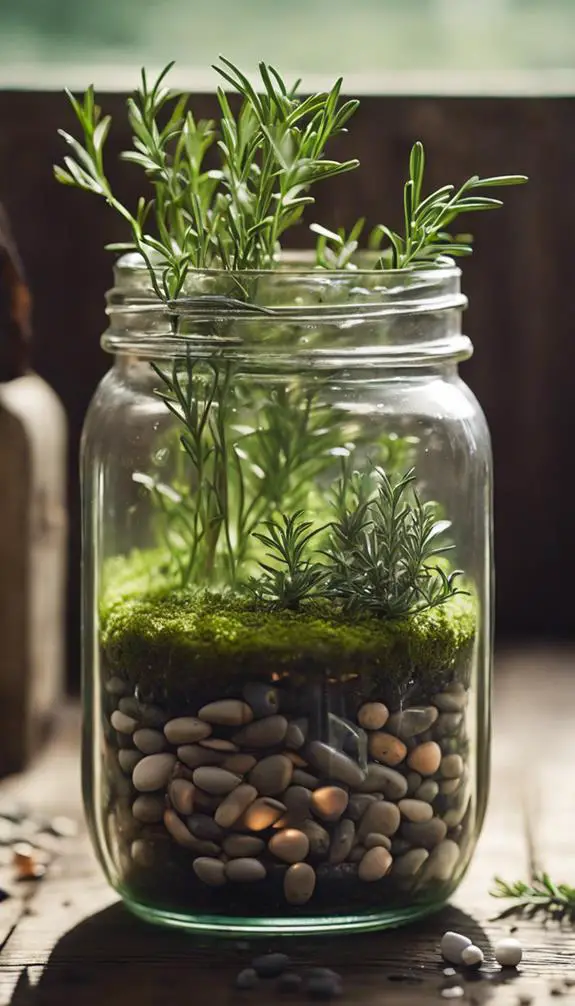When you decide to grow petunias in pots, you're likely envisioning a vibrant display of colorful blooms spilling over the container's edges. But before you can achieve that stunning look, you'll need to get the basics right. You'll want to select a petunia variety that's well-suited to your local climate and desired flower color, and then choose a container that provides enough room for the roots to grow. But that's just the beginning – proper soil, watering, and fertilization are also vital for success. With the right foundation in place, you'll be on your way to enjoying a thriving petunia display, but what else do you need to know to guarantee your potted petunias reach their full potential?
Summary
- Choose a container that's at least 12-18 inches wide and 6-8 inches deep to accommodate petunias' mature size and root system.
- Select a potting mix that provides good drainage, aeration, and water-holding capacity, with a slightly acidic to neutral soil pH.
- Water petunias when the top 1-2 inches of soil feel dry to the touch, avoiding getting water on the leaves to prevent fungal diseases.
- Provide petunias with at least six hours of direct sunlight, and position pots in locations receiving morning sun and afternoon shade.
- Fertilize petunias with a balanced, water-soluble fertilizer, following the manufacturer's instructions, and avoid over-fertilizing.
Choosing the Right Petunia Variety

When selecting petunias for container gardens, weighing the specific growing conditions and desired outcomes is crucial.
You'll want to choose petunia types that thrive in your local climate and provide the desired flower colors. If you're looking for a compact, low-maintenance option, ponder spreading petunias like 'Purple Wave' or 'Blue Danube'.
For a more dramatic display, try upright varieties like 'Super Cascade' or 'Tidal Wave'.
Don't forget to ponder the flower colors – do you want bold and bright, or soft and pastel?
Petunias come in a wide range of hues, from classic red and pink to unique shades like lavender and coral.
Selecting the Perfect Container

When selecting the perfect container for your petunias, you'll need to ponder three key factors.
First, you'll want to choose a container that's large enough to accommodate the mature size of your plants, as petunias can grow quite vigorously.
You'll also need to think about the material and drainage capabilities of the container, as these will impact the health and happiness of your petunias.
Container Size Matters
How much soil space do petunias really need to thrive in pots?
The answer lies in understanding the importance of pot depth and container width impact. Petunias have a deep taproot, so they require a minimum pot depth of 6-8 inches to accommodate their root system.
However, if you're growing compact or dwarf varieties, you can get away with shallower pots.
Container width also plays a vital role, as it affects soil temperature and moisture levels. A wider container guarantees better air circulation and prevents waterlogging.
Aim for a container that's at least 12-18 inches wide to provide your petunias with the room they need to spread out and flourish.
Material Makes a Difference
Now that you've chosen the right container size, it's time to think about the material it's made of.
The pot material substantially impacts planter durability and, subsequently, your petunias' health. You'll want a material that's resistant to weathering, cracking, and fading.
Plastic and ceramic pots are popular choices, but they can become brittle over time. Wooden planters, on the other hand, can rot if not properly treated.
Consider innovative materials like fiberglass, polypropylene, or recycled plastic, which offer superior durability and resistance to the elements. These modern options guarantee your petunias receive the right amount of water and nutrients, while also withstanding harsh weather conditions.
Drainage Is Essential
Proper drainage is the cornerstone of a thriving petunia container garden, as it directly affects the plant's ability to absorb essential nutrients and water.
You'll want to guarantee your pot has a reliable drainage system to prevent waterlogged roots, which can lead to root rot and plant death.
Look for containers with built-in drainage holes or add your own by drilling holes in the bottom of the pot.
You can also use a well-draining potting mix and add materials like perlite or vermiculite to improve drainage.
Soil and Fertilizer Requirements
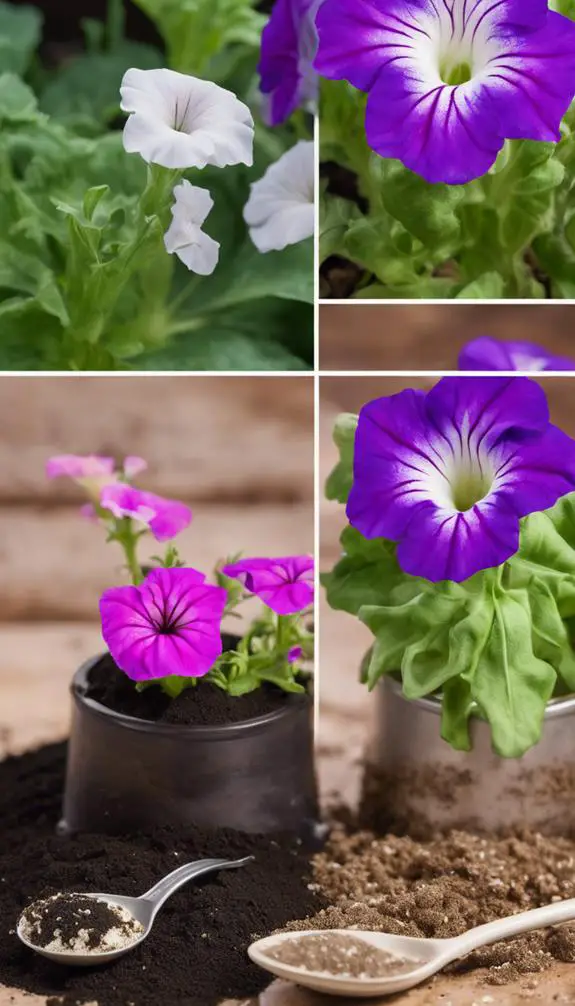
You'll want to choose a potting mix that provides good drainage and aeration, as petunias thrive in well-oxygenated soil.
A mix specifically designed for flowering plants will typically contain a blend of peat moss, vermiculite, and perlite, which helps retain moisture and nutrients.
Soil Composition Matters
Three key components make up a well-balanced potting mix for growing petunias: peat moss, vermiculite, and perlite.
These components provide the necessary structure, aeration, and water-holding capacity for ideal root growth.
You'll want to guarantee your potting mix has a slightly acidic to neutral soil pH, ranging from 6.0 to 7.0.
This will allow your petunias to absorb essential nutrients efficiently.
Organic matter, such as compost or humus, is also vital, as it retains moisture, suppresses diseases, and provides a food source for beneficial microorganisms.
Potting Mix Options
Selecting the right potting mix for your petunias can be overwhelming, given the numerous options available on the market.
You'll want to choose a mix that provides good drainage, aeration, and water-holding capacity. Consider organic blends that incorporate peat alternatives, such as coconut coir or bark, which offer improved sustainability and eco-friendliness.
These alternatives can help reduce the environmental impact of peat harvesting while still providing the necessary structure and moisture retention for your petunias. Look for mixes with a balanced pH and a mix of fine and coarse particles to guarantee maximum root growth.
Fertilizer Application Tips
With your petunias planted in a well-draining potting mix, it's time to focus on providing them with the necessary nutrients for maximum growth.
You'll want to fertilize your petunias regularly to promote healthy development. A balanced, water-soluble fertilizer applied at half the recommended strength will provide a strong foundation.
For an extra boost, consider foliar feeding with a micronutrient-rich solution to enhance leaf growth and color. Additionally, incorporate root stimulants into your fertilizer routine to encourage robust root development, which will support your petunias' overall health.
Planting Petunias in Pots
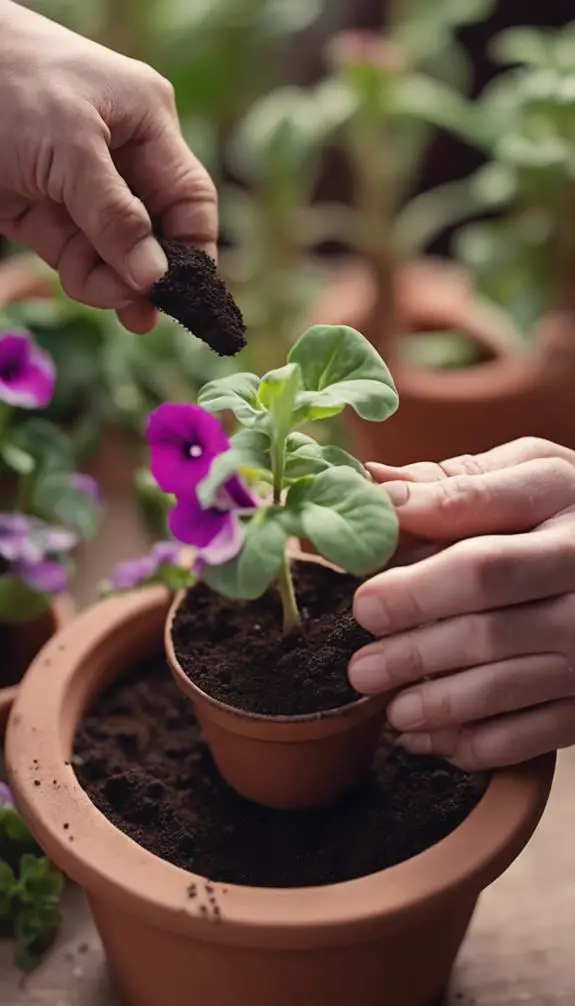
You'll need a container that's at least five to seven inches deep to accommodate petunias' deep roots.
When selecting a pot, consider one with good drainage holes to prevent waterlogged soil.
For potting tips, use a high-quality potting mix specifically designed for flowering plants.
Begin soil prep by filling the container about 2/3 with potting mix, then gently removing the petunia from its pot.
Place the plant in the container, taking care not to disturb the roots.
Add more potting mix around the roots, gently firming it in place.
Leave about an inch of space between the soil surface and the top of the container for easy watering.
Proper Watering Techniques

When growing petunias in pots, you'll need to establish a consistent watering schedule that meets their specific needs.
To do this, you'll need to regularly check the moisture level of the soil, ensuring it's not too dry or waterlogged.
Watering Schedule Essentials
By the time your petunias are thriving in their pots, they'll require consistent moisture to maintain their vibrant colors and healthy growth.
Debunking common watering myths, crucial to establish a watering schedule that works for you and your plants.
Start with a morning routine, checking the soil moisture before watering.
Aim to provide about 1-2 inches of water per week, either through rainfall or irrigation.
Water your petunias when the top 1-2 inches of soil feel dry to the touch.
Avoid getting water on the leaves to prevent fungal diseases.
Instead, water at the soil level, allowing the pot to drain excess water.
Moisture Level Checks
Checking the moisture level of your petunia potting mix is a crucial step in determining when to water.
You can do this by inserting your finger into the soil up to the first knuckle or by using advanced tools like soil probes or moisture meters.
These devices provide precise readings of the soil's moisture levels, ensuring you water only when necessary.
When using a soil probe, gently push it into the soil and wait for a few seconds to get an accurate reading.
Moisture meters, on the other hand, provide a digital reading, making it easy to determine the exact moisture level.
Drainage Hole Maintenance
Proper drainage is essential for petunias in pots, and it starts with maintaining those small but crucial drainage holes.
You'll want to check them regularly to verify they're not clogged with debris or soil. Use a toothpick or small twig to gently clean out any blockages, making sure not to push debris further into the hole.
This hole cleaning routine will prevent clogged drainage holes, which can lead to waterlogged soil and root rot. By keeping your drainage holes clear, you'll be able to water your petunias effectively, providing them with the right amount of moisture without risking overwatering.
This preventive maintenance will pay off in the long run, guaranteeing your petunias thrive in their pots.
Providing Adequate Sunlight
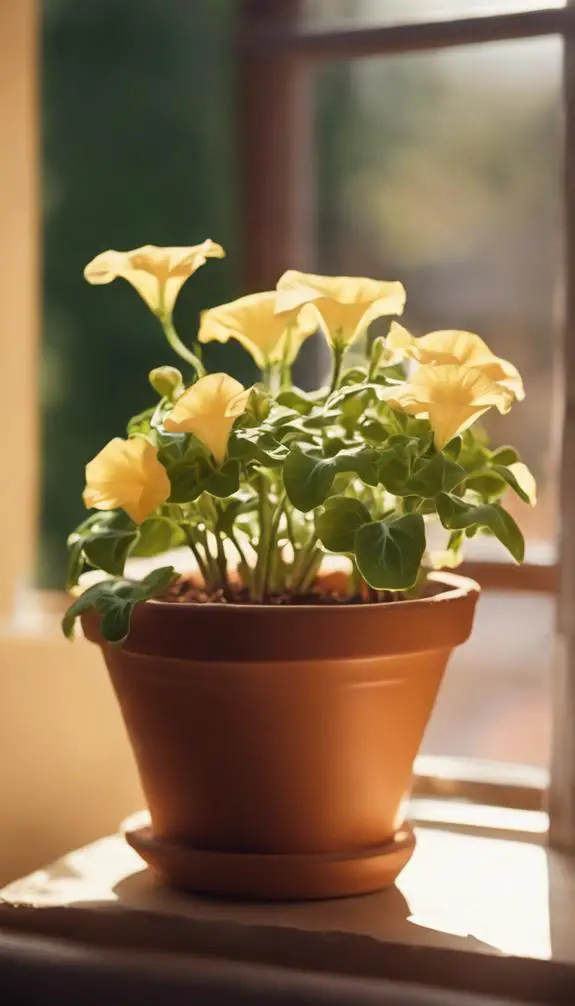
Petunias thrive in sunny conditions, and pots offer the flexibility to move them to the ideal spot.
Since petunias require at least six hours of direct sunlight, you'll want to position your pot in a location that receives morning sun and afternoon shade.
East- or west-facing windows or balconies are perfect for petunias, as they provide gentle, indirect light.
If you're placing your pot outdoors, choose a spot that receives direct sunlight for half the day and dappled shade for the other half.
Be mindful of intense afternoon sun, which can scorch petunia leaves.
Temperature and Humidity Control
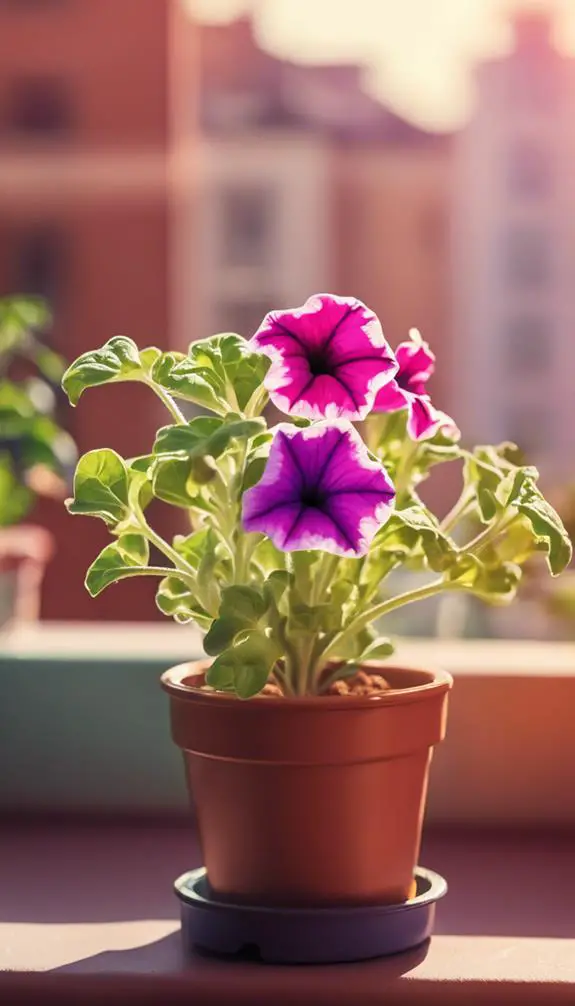
With petunias in pots, you have the flexibility to control temperature and humidity levels to create an ideal growing environment.
Petunias thrive in temperatures between 65°F to 75°F (18°C to 24°C), making it essential to place them in an area that maintains a consistent climate.
You can achieve climate control by moving the pots to a shaded area during intense summer heat or bringing them indoors during cooler nights.
Monitor humidity levels, as petunias prefer a relative humidity of 50-60%.
You can increase humidity around the plants by placing the pot on a tray filled with water and pebbles or using a humidifier.
Pruning and Deadheading
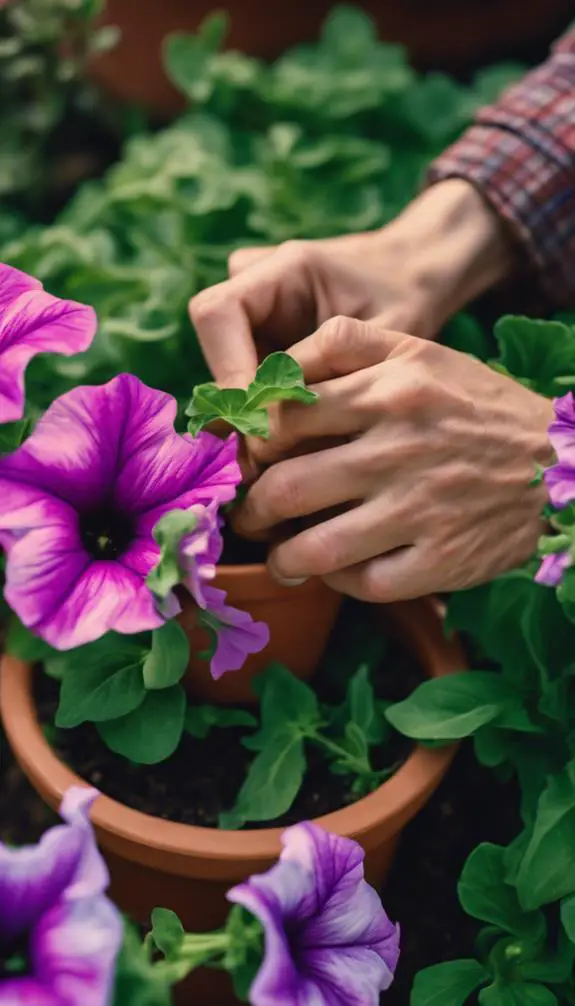
As you're enjoying the vibrant blooms of your potted petunias, remember that regular pruning and deadheading are essential to maintain their appearance and promote healthy growth.
Pinching tips of your petunias encourages bushy growth and more blooms. Simply pinch off the top inch of each stem, just above a leaf node, to stimulate branching.
Deadheading, or removing spent blooms, prevents seed production and redirects the plant's energy towards producing more flowers. When deadheading, trim the stem just above a leaf node or a lateral bud to encourage new growth.
You can also use stem cuttings from your pruned petunias to propagate new plants. By incorporating regular pruning and deadheading into your care routine, you'll enjoy a lush, thriving display of petunias all season long.
Pest and Disease Management
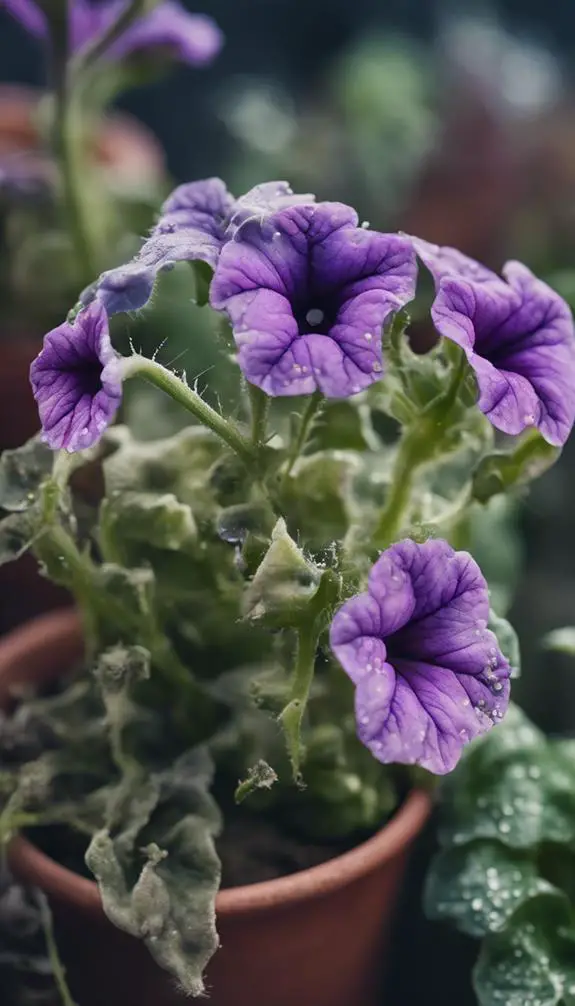
While your potted petunias are basking in the sun, unwanted visitors may be lurking, threatening to spoil the party.
Keep an eye out for pest attractants like aphids, whiteflies, and spider mites, which can weaken your plants and spread disease. Regularly inspect your plants for signs of infestation, such as sticky leaves or tiny eggs.
To break disease cycles, maintain good hygiene by disinfecting pruning tools and removing infected plants. Prevent fungal diseases by avoiding overwatering and ensuring good air circulation.
Use organic pest control methods like neem oil or insecticidal soap to target specific pests without harming beneficial insects. Stay vigilant, and you'll be able to enjoy a vibrant, pest- and disease-free petunia display all season long.
Fertilizing for Optimal Growth

Feed your potted petunias a balanced diet to release their full potential. A well-formulated fertilizer provides essential nutrients for healthy growth.
Petunias thrive in slightly acidic to neutral soil pH, between 6.0 and 7.0. You can use a water-soluble fertilizer, following the manufacturer's instructions.
For added boost, try foliar feeding – spraying a diluted fertilizer solution directly on the leaves. This method promotes nutrient uptake and enhances growth.
Avoid over-fertilizing, as it can damage your petunias. Regularly check the soil pH and adjust your fertilizer accordingly.
Managing Petunia Growth Habits

Petunias in pots can become leggy and unruly if left unpruned, overtaking their containers and neighboring plants.
To manage their growth, you'll need to prune them regularly. Pinch off the terminal buds to encourage branching, creating a fuller plant. Remove any weak or spindly growth to direct the plant's energy towards producing more blooms.
Petunia pruning also helps maintain a bushy shape, preventing them from becoming leggy. Keep an eye on your petunia's growth patterns, and trim back long stems to about half their length.
This will stimulate new growth and more flowers. By pruning regularly, you'll be rewarded with a lush, vibrant display of petunias that thrive in their containers.
Common Problems to Watch For

When growing petunias in pots, you'll need to be vigilant for certain common problems that can hinder their growth and appearance.
One issue to watch for is root bound, where the plant's roots outgrow the pot, leading to stunted growth and reduced blooming. Check for signs like slow growth, yellowing leaves, or roots growing out of the drainage holes.
Another problem is pests, which attract aphids, whiteflies, and spider mites. These pests can spread disease and weaken your petunias.
Regularly inspect your plants for signs of infestation, such as sticky leaves, webs, or actual pests. Take action promptly to prevent these issues from taking hold and affecting your petunias' health.
Extending the Blooming Season

To maximize your petunias' blooming period, you'll want to implement strategies that promote continuous flowering.
One way to do this is by using season extenders, which can provide protection from frost and extend the growing season.
You can also try cold stratification, a process that involves subjecting petunia seeds to cold temperatures to stimulate germination and promote earlier blooming.
Additionally, consider deadheading spent flowers, fertilizing regularly, and providing adequate light and water to keep your petunias healthy and blooming.
FAQs
Can Petunias in Pots Be Brought Indoors During Winter?
When winter arrives, you can bring petunias in pots indoors for winter care, providing them with bright, indirect light and cooler temperatures. Store them in a dry, frost-free area with reduced watering, and they'll thrive until outdoor conditions improve.
How Do I Prevent Petunias From Becoming Leggy?
To prevent leggy petunias, you're focusing on pruning habits, specifically pinching off terminal buds to encourage branching. By maintaining a shorter stem length, you'll promote bushy growth, so regularly trim back stems to about one-third to one-half of their height.
Can I Grow Petunias in Hanging Baskets?
You can grow petunias in hanging baskets, opting for a minimum 12-inch basket size to accommodate the plant's spread. Follow hanging tips like using a sturdy hook, facing the basket east or west, and ensuring adequate air circulation to promote healthy growth.
Are Petunias Safe for Pets to Be Around?
You're wise to ponder pet toxicity concerns; as you introduce petunias into your space, guarantee your furry friend's safety by knowing that, while not typically toxic, petunias can still cause mild gastrointestinal upset if ingested, so keep an eye out.
Can I Divide and Re-Pot Petunias in the Fall?
When fall arrives, you can divide and re-pot petunias, taking advantage of Petunia propagation. During fall care, gently dig up the plant, separate the roots, and re-pot the divisions in fresh soil with proper drainage and nutrients.
Conclusion
You've successfully grown petunias in pots by following these guidelines. Now, enjoy the vibrant blooms and lush foliage. Remember to maintain consistent watering, fertilization, and pruning to promote healthy growth. With proper care, your petunias will thrive, providing a stunning display of color throughout the growing season.



